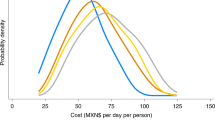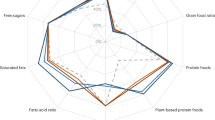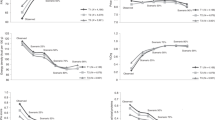Abstract
The amounts of animal-sourced foods required to achieve a least-cost nutritious diet depend on the food prices prevalent in each country. Using linear programming, we determine least-cost dietary patterns in the United States and the constituent amounts of animal-sourced foods. We considered local foods and prices from 2009–2010, and the average energy and nutrient requirements of adults. Nutrient-adequate food patterns were estimated at US$1.98 per day and included animal and plant products. Limiting nutrients were α-linolenic acid, potassium, choline, and vitamins C, D, E and K. The prices of animal-based foods had to be increased by 2–11.5 times to be excluded from the modelled food pattern, with the least cost of a plant-only diet at US$3.61. Given relative food prices in the United States, we show that animal-based foods are needed to secure adequate nutrition at the lowest cost, underscoring the role of price and market mechanisms in the choice of nutrient-adequate, sustainable diets.
This is a preview of subscription content, access via your institution
Access options
Access Nature and 54 other Nature Portfolio journals
Get Nature+, our best-value online-access subscription
$29.99 / 30 days
cancel any time
Subscribe to this journal
Receive 12 digital issues and online access to articles
$119.00 per year
only $9.92 per issue
Buy this article
- Purchase on Springer Link
- Instant access to full article PDF
Prices may be subject to local taxes which are calculated during checkout

Similar content being viewed by others
Data availability
All data used and generated during the current study are available from an online resource (https://gitlab.com/thetasolutionsllc/naturefood-19100372).
Code availability
The computer code required to reproduce the findings of this study is available from an online resource (https://gitlab.com/thetasolutionsllc/naturefood-19100372).
References
Biodiversity and Sustainable Diets: United Against Hunger (FAO, 2010).
Drewnowski, A. in Sustainable Nutrition in a Changing World 25–34 (Springer, 2017).
National Nutrient Database for Standard Reference Release 28 (USDA, 2016); http://www.ars.usda.gov/nea/bhnrc/mafcl.
Rehm, C. D., Monsivais, F. & Drewnowski, A. Relation between diet cost and Healthy Eating Index 2010 scores among adults in the United States 2007–2010. Prev. Med. 73, 70–75 (2015).
Darmon, N. & Drewnowski, A. Contribution of food prices and diet cost to socioeconomic disparities in diet quality and health: a systematic review and analysis. Nutr. Rev. 73, 643–660 (2015).
Headey, D. D. & Alderman, H. H.The relative caloric prices of healthy and unhealthy foods differ systematically across income levels and continents. J. Nutr. 149, 2020–2033 (2019).
Dantzig, G. B. Linear Programming and Extensions (Princeton Univ. Press, 1963).
Van Dooren, C. A review of the use of linear programming to optimize diets, nutritiously, economically and environmentally. Front. Nutr. 5, 48 (2018).
Darmon, N., Ferguson, E. L. & Briend, A. Impact of a cost constraint on nutritionally adequate food choices for French women: an analysis by linear programming. J. Nutr. Educ. Behav. 38, 82–90 (2006).
Cleveland, L. E., Escobar, A. J., Lutz, S. M. & Welsh, S. O. Methods for identifying differences between existing food intake patterns and patterns that meet nutrition recommendations. J. Am. Diet. Assoc. 93, 556–560, 563 (1993).
National Academies of Sciences, Engineering, and Medicine Dietary Reference Intakes for Sodium and Potassium (National Academies Press, 2019).
Institute of Medicine Dietary Reference Intakes for Energy, Carbohydrate, Fiber, Fat, Fatty Acids, Cholesterol, Protein, and Amino Acids (National Academies Press, 2002).
Institute of Medicine Dietary Reference Intakes: The Essential Guide to Nutrient Requirements (National Academies Press, 2006).
Institute of Medicine Dietary Reference Intakes for Water, Potassium, Sodium, Chloride, and Sulfate (National Academies Press, 2005).
Nicklas, T. A., O’Neil, C. E. & Fulgoni, V. L. III The role of dairy in meeting the recommendations for shortfall nutrients in the American diet. J. Am. Coll. Nutr. 28, 73–81 (2009).
2015–2020 Dietary Guidelines for Americans (USHHS, USDA, 2015).
IPCC Special Report on Global Warming of 1.5 °C (eds Masson-Delmotte, V. et al.) (World Meteorological Organization, 2018).
Willet, W. et al. Food in the Anthropocene: the EAT–Lancet Commission on healthy diets from sustainable food systems. Lancet 393, 447–492 (2019).
Adesogan, A. T., Havelaar, A. H., McKune, S. L., Eilitta, M. & Dahl, G. E. Animal source foods: sustainability problem or malnutrition and sustainability solution? Perspective matters. Glob. Food Secur. https://doi.org/10.1016/j.gfs.2019.100325 (2019).
Darmon, N., Ferguson, E. L. & Briend, A. Linear and nonlinear programming to optimize the nutrient density of a population’s diet: an example based on diets of preschool children in rural Malawi. Am. J. Clin. Nutr. 75, 245–253 (2002).
Darmon, N., Lacroix, A., Muller, L. & Ruffieux, B. Food price policies improve diet quality while increasing socioeconomic inequalities in nutrition. Int. J. Behav. Nutr. Phys. Act. 11, 66 (2014).
Briend, A. & Darmon, N. Determining limiting nutrients by linear programming: a new approach to predict insufficient intakes from complementary foods. Pediatrics 106, 1288–1289 (2000).
Hirvonen, K., Bai, Y., Headey, D. & Masters, W. A. Affordability of the EAT–Lancet reference diet: a global analysis. Lancet Glob. Health 8, 59–66 (2020).
Alston, J. M., Sumner, D. A. & Vosti, S. A. Farm subsidies and obesity in the United States: national evidence and international comparisons. Food Policy 33, 470–479 (2008).
Poverty Thresholds (US Census Bureau, 2010); https://www.census.gov/topics/income-poverty/data/tables.2010.html.
Moughan, P. J. Holistic properties of foods: a changing paradigm in human nutrition. J. Sci. Food Agric. https://doi.org/10.1002/jsfa.8997 (2018).
Bezanson, J., Edelman, A., Karpinski, S. & Shah, V. B. Julia: a fresh approach to numerical computing. SIAM Rev. 59, 65–98 (2017).
Dunning, I., Huchette, J. & Lubin, M. JuMP: a modeling language for mathematical optimization. SIAM Rev. 59, 295–320 (2017).
Balintfy, J. L. Menu planning by computer. Commun. ACM 7, 255–259 (1964).
Stigler, G. J. The cost of subsistence. J. Farm Econ. 27, 303–314 (1945).
Buttris, J. L. et al. Diet modelling: how it can inform the development of dietary recommendations and public health policy. Nutr. Bull. 39, 115–125 (2014).
Gazan, R. et al. Mathematical optimization to explore tomorrow’s sustainable diets: a narrative review. Adv. Nutr. 9, 602–616 (2018).
Gephart, J. A. et al. The environmental cost of subsistence: optimizing diets to minimize footprints. Sci. Total Environ. 553, 120–127 (2016).
Code of Federal Regulations: Title 21—Food and Drugs Vol. 2, Section 101.12 (US FDA, 2017); https://www.accessdata.fda.gov/scripts/cdrh/cfdocs/cfcfr/cfrsearch.cfm?fr=101.12.
Institute of Medicine Dietary Reference Intakes for Calcium, Phosphorus, Magnesium, Vitamin D and Fluoride (National Academies Press, 1997).
Institute of Medicine Dietary Reference Intakes for Thiamine, Riboflavin, Niacin, Vitamin B6, Folate, Vitamin B12, Pantothenic Acid, Biotin, and Choline (National Academies Press, 1998).
Institute of Medicine Dietary Reference Intakes for Vitamin C, Vitamin E, Selenium, and Carotenoids (National Academies Press, 2000).
Institute of Medicine Dietary Reference Intakes for Vitamin A, Vitamin K, Arsenic, Boron, Chromium, Copper, Iodine, Iron, Manganese, Molybdenum, Nickel, Silicon, Vanadium, and Zinc (National Academies Press, 2001).
Institute of Medicine Dietary Reference Intakes for Calcium and Vitamin D (National Academies Press, 2011).
Haytowitz, D. B. et al. Key foods: setting priorities for nutrient analyses. J. Food Composit. Anal. 9, 331–364 (1996).
Haytowitz, D. B., Pehrsson, P. R. & Holden, J. M. The identification of key foods for food composition research. J. Food Composit. Anal. 15, 183–194 (2002).
Haytowitz, D. B. Updating USDA’s key foods list for what we eat in America, NHANES 2011–12. Procedia Food Sci. 4, 71–78 (2015).
Kuczmarski, R. J. et al. 2000 CDC growth charts for the United States: methods and development. Vital Health Stat. 246, 1–190 (2002).
Acknowledgements
The work reported was supported in part through funds from the National Dairy Council and Global Dairy Platform.
Author information
Authors and Affiliations
Contributions
S.M.S.C. and P.J.M. were responsible for the design and analysis of the study. D.P.G. was responsible for the linear programming modelling and analysis. A.D. was responsible for the provision of databases and consulting on the linear programming models. S.M.S.C. prepared the first draft of the manuscript. P.J.M revised the first draft of the manuscript. All authors participated in interpretation of the results and have read and approved the final manuscript.
Corresponding author
Ethics declarations
Competing interests
The authors declare no competing interests.
Additional information
Publisher’s note Springer Nature remains neutral with regard to jurisdictional claims in published maps and institutional affiliations.
Supplementary information
Supplementary Table 1
Sensitivity analysis, with the shadow prices for all constraints sitting at either minimum or maximum, for linear programming analysis 1 and linear programming analysis 3.
Rights and permissions
About this article
Cite this article
Chungchunlam, S.M.S., Moughan, P.J., Garrick, D.P. et al. Animal-sourced foods are required for minimum-cost nutritionally adequate food patterns for the United States. Nat Food 1, 376–381 (2020). https://doi.org/10.1038/s43016-020-0096-8
Received:
Accepted:
Published:
Issue Date:
DOI: https://doi.org/10.1038/s43016-020-0096-8
This article is cited by
-
The water footprint and nutritional implications of diet change in Mexico: a principal component analysis
European Journal of Nutrition (2022)
-
Comparison of carbon footprint and water scarcity footprint of milk protein produced by cellular agriculture and the dairy industry
The International Journal of Life Cycle Assessment (2022)
-
The value of animal-sourced foods
Nature Food (2020)



